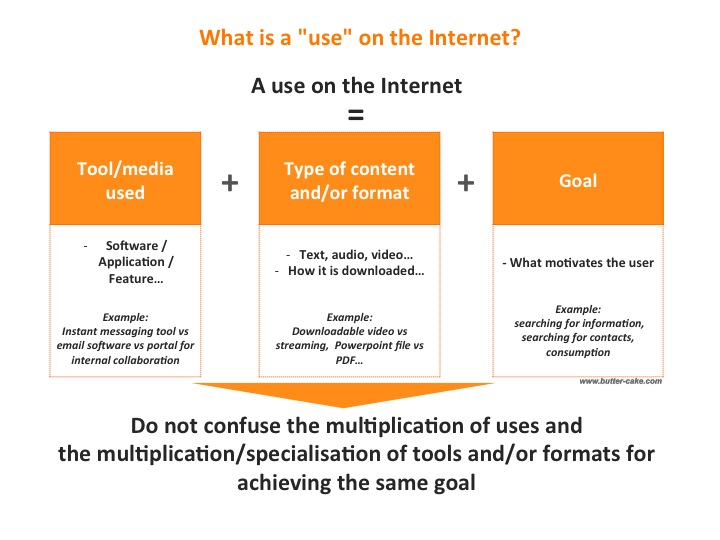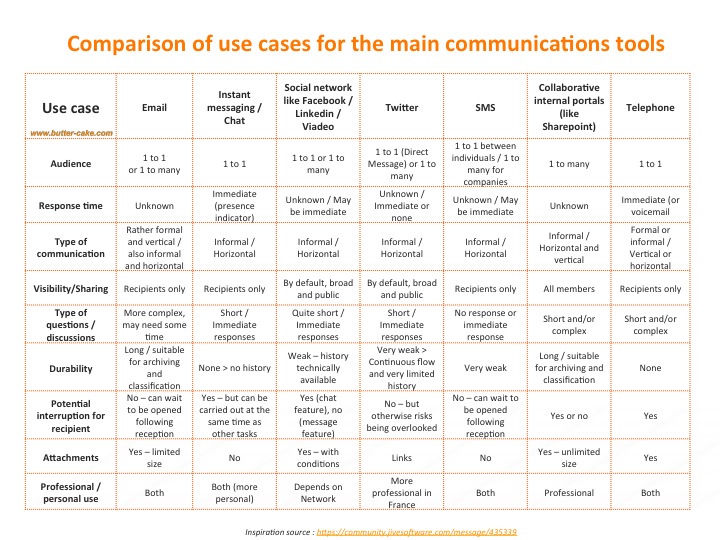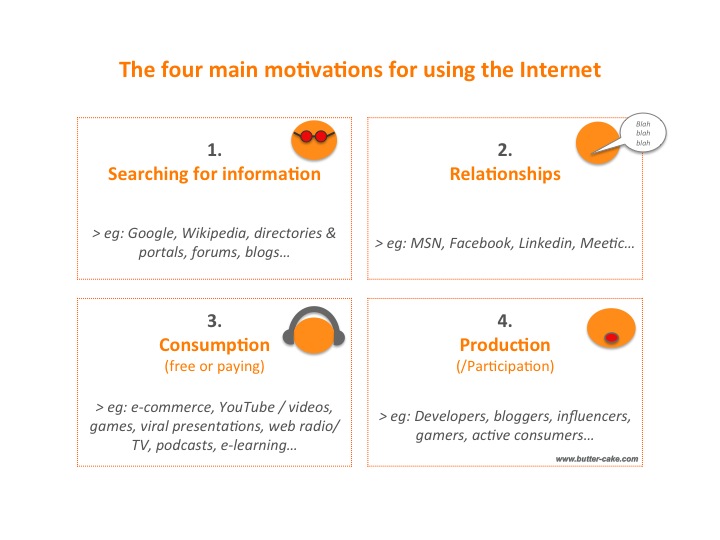Overview: Today, almost everyone is on the Internet. Writing down the many uses in a list that gets longer each year is no longer of any use to brands looking to analyse the web. Instead, they need to step back and look at the main starting motivations of Internet users (searching for information, building relationships, consumption and production) to see where these cross over with the brand’s objectives and thus find the right place for the Internet compared to other media and channels. The Internet is basically a medium of utility, experience and relationships, far less than it is one of image and emotion. It is of far greater benefit for those who participate in it regularly instead of focusing on occasional, tactical use.
The Internet has become an everyday tool for the majority of the population. Writing down the ever-growing list of things it can be used for is not enough for us to understand what motivates Internet users, and may even have the opposite effect by giving the impression that behaviour is becoming more complex and that trends are arriving one after the other at breakneck speed. This is not really the case, especially in a mature country like France. So how can we draw conclusions that enable a company to act?
Just as the metaphor of spaces enables us to capture the essence of the places that make up the web and how they relate to each other, it is important to keep the same perspective when it comes to capturing the basic motivations that drive people to use the Internet, how they go about achieving their goals and what criteria they use when making their choices. Combining this with the objectives of brands and companies allows us to define the scope in which the latter can operate, as well as the most appropriate strategy in terms of means and content.
Who are the Internet users and how do they use the web?
70% of French people are Internet users, of which 97% have broadband at home. Their profile is growing closer and closer to that of the French population as a whole in terms of gender (male versus female) and income group (although studies and interpretations vary depending on the source: TNS versus M@rsouin, for instance).
The most significant difference between the population of Internet users and the French population as a whole is that of age, with younger people still over-represented and those over 50 under-represented on the web. The presence of a majority of the population on the web and the diversification of uses show above all that these criteria are not really discriminatory (except perhaps for the elderly, and even then…), since they are becoming more and more like people’s real-life uses, i.e. the Internet now touches nearly every area of our lives. It should also be noted that unlike other mature countries, the balance of consumption of mainstream media has remained stable in France, with the growth of the Internet not stopping the daily consumption of TV and radio (for 57% of all French people: source TNS).
Uses are less mature among mobile users, with the profile of the average mobile user corresponding to that of the average Internet user in the 90s according to Ipsos MediaCT: but given the growing penetration of smartphones (43.5 million French people, i.e. 81% of the population, owns a mobile phone, and one in three of those have a smartphone, three times more than two years ago according to the Mobile Consumer Insight study by Médiamétrie in April 2011) and the development of mobile app platforms, this maturing of uses in mobility will certainly be structured fairly quickly, at least for the main, transversal uses.
Apart from specific targets (the elderly, mobile users), we need to find other ways of looking at Internet usage if we are to draw any useful conclusions for brands or companies. This raises the following question: are these uses really increasing dramatically, or is it that the features and applications becoming richer now allow us to use different tools and materials to achieve a similar goal?
Trends: content and form
What is a “use”? Let’s take this notion apart and see what it is made up of. A “use” means carrying out a regular action in order to achieve a final objective, using a tool or medium. If we separate content and form, the main elements of a “use” are:
– The type of tool or media = applications / services / sites used (for instance, instant messaging tool versus email software versus a social network, all three of which enable communication between different people)
– The type of content and/or format used, depending on what best corresponds to the goal to be achieved (video, audio, text, slideshow, and whether or not they are downloadable…)
– The goal, which is what motivates the user
This analysis lets us stand back a little since, by separating content and form, we can see that there are certainly some uses that grow as technical possibilities increase – while at the same time others are declining or becoming more specialised, with Internet users changing tools or applications to continue to achieve the same goal (or simply preferring some tools to others depending on their age). In the example below, we can see for instance that there is a strong potential for cannibalisation between Facebook, Twitter, chat/IM tools and SMS, which may explain the decline of some of them to the benefit of others. However, the use of email in a professional context has few competitors combining all its advantages, even if for a short, immediate response it is not necessarily the best tool… The limits of specialisation are directly linked to the capacity or tolerance of human beings to manage many tools rather than a limited number!
Understanding Internet users’ initial motivations is thus key to shedding light on how they use the web.
What are our main goals when we use the Internet?
Studies often show different types of motivations for users, which each institute will class differently according to its own criteria (e.g. TNS Digital Life vs Wave 5 de Universal McCann). When we look more closely and compare these motivations with those sites that have the largest audience on the Internet, we realise that we can group all activities on the Internet under four main types of objectives:
1. Searching for information: You just have to look at the success of Google, Wikipedia or forums, to name three different examples, to understand that searching for information of any sort and at any level of depth or expertise is one of the most important motivations for using the Internet, if not the main one. The type of information being looked for may vary depending on age, sex, and on personal or professional situation… but the initial motivation is the same in each case.
2. Building and maintaining relationships: whether getting in touch with someone or communicating with someone, be it on instant messaging with friends, sending emails or carrying out an exchange on Facebook – the relationship-building dimension of the web plays a dominant role thanks to its interactive nature, even more so on the mobile phone, and should not be limited to personal relationships. Conversely, everything should not be put under the umbrella of “relationship-building”, as brands have a tendency to think – the original motivation of the user must be examined. Often the motivation which brands call as “relationship-building” is in fact a search for information or services, with the ultimate goal of making a purchase… let’s not forget that the main goal for a consumer with regard to a brand is that of purchasing and using the brand’s product! In this case, the “relationship-building” dimension is not a goal in itself but a means of achieving a goal.
3. Consumption, in the broadest economical sense of the term, that is to say “the action of using or destroying, immediately or gradually, goods or services in order to satisfy a need”, which may be either “paying” consumption in the usual sense of the term, either on the Internet or via the Internet (e-commerce), or “free” consumption of goods and services, such as watching videos on YouTube, reading blogs or playing with free games apps on your mobile phone… All of that fits under the goal of consumption. Searching for information is often carried out with the aim of future consumption, and relationships are often used to enable future consumption as well.
Depending on the internet user’s initial motivation, the desire for consumption will not be the same and will guide the choice of activity, media and content: entertainment versus business, for instance; immediate (as a form of distraction) or to meet a greater need such as preparing to move house, etc.
Depending on the type of display or device used to access the Internet (desktop computer, laptop, tablet, mobile phone or connected display) and the initial posture (physical posture: leaning forward for search, or leaning back in relaxed mode), the time of consumption and the products/services being sought, the openness (or lack thereof) of the user to other distractions, such as advertising for instance, will not be the same: this aspect should be examined more closely depending on the category the brand’s products fall into. For instance, an entertainment brand or a brand that uses entertainment in its communications will have far more legitimacy on Facebook than other types of brands, and probably more success, as the main motivation of Facebook users is in the private domain and is related to relaxation, so they will be more receptive to things that fuel their motivation, and less receptive to those that disturb it…
4. Production (/participation): When it comes to producing content or carrying out a professional task, or even a full-time job, this category groups together all those people who are active producers on the Internet and who are driven by this main motivation for much of the time they spend on the web. Depending on the sources and the particular context being studied, this active minority makes up between 10% and 20% on average of all Internet users. Bloggers, forum moderators, developers and all those who create, produce or manage content on the Internet may be placed in this category, as what distinguishes them first and foremost is not the type of content they produce, but the very fact that they are producers and the degree of commitment they demonstrate. They are often motivated by a desire to influence others, whether for ideological reasons or for professional advancement, but it would be over-simplifying matters to limit influencers to “producers” on the web and vice versa. In a broader sense, this category could include any Internet user or active consumer who participates by expressing an opinion on a given subject.
These types of motivations are not mutually exclusive, of course, because we are dealing with human beings: indeed, it is this “multi-faceted” nature of Internet users that often creates confusion for brands and advertisers. Mistakenly, as what must take priority is the main starting motivation. For instance, if I am looking for information about a product I want to buy, I may well ask a friend if I think he can give me the information more quickly or if I can trust what he tells me more than other sources, but my motivation in this case is not to strengthen our relationship, but rather to find the information in question. Just like in real life, if I want to buy some medicine and I stumble upon a chemist’s on the way to a business meeting, I can easily stop there to meet this need. But I’m not going to stop at the chemist’s just because it is on my way! What changes with the Internet is that, in a sense, the chemist’s is “always” on my way, which means that Internet users may often “change hats” several times over a single day or during a particular time period if they are online. This explains why the Internet is an excellent PULL media (content available on demand) and can often become very intrusive in PUSH mode, since the effectiveness of such a mode depends on repetition to arrive at “the right time” and users have been demonstrated to suffer form blindness the rest of the time (ad banners, fall in the rate of emails being opened…).
In conclusion, understanding what motivates consumers to use the Internet must be the first priority of any brand or company that wants to use the web effectively. From these four broad starting categories, a brand must dig into the particular motivations of its target or targets, relative to its industry and product category, since that is what will largely determine the breadth of its expected and legitimate scope of actions on the Internet, and the role assigned to the Internet compared to other media or channels. Will people use the Internet in the same way when looking for information about toothpaste, the next film they want to see, or when buying a new car? Will the Internet enable all brands to develop the reputation of a new product (and in the same way) as much as its purchase online?
Of course not… because the Internet, as we can see from the use that is made of it, is primarily a media of convenience and of experience (in the sense of the interaction I have with a brand or service, not in the exposure to its images and videos) and of relationship-building. It is thus a media of content and exchange, of targeting and efficiency, which performs better over time than in an instant, and which is of more benefit to those who practise it regularly than to those whose presence is occasional and tactical. At its heart, the Internet is not a media of image or emotion, unlike television for instance which is its perfect complement for those two elements, although it can be for those on more limited budgets or in niche areas.
Once this understanding has been clarified and the “decision tree” of consumers/users has been outlined in a diagram in relation to a category or a product, that is to say once we know what they are looking for and the role played by the Internet in the search, it may prove useful to understand how the users go about reaching their goal: what places/sites on the Internet space do they visit to achieve their goal, how do they find them and what criteria do they use in choosing which ones to visit? This will enable the brand to plan its strategy in terms of content and resources accordingly. This last dimension is developed in the following article that completes this overview of the Internet.
This article is the third chapter of the ebook « Building a digital strategy », available for download in PDF format on this site.



